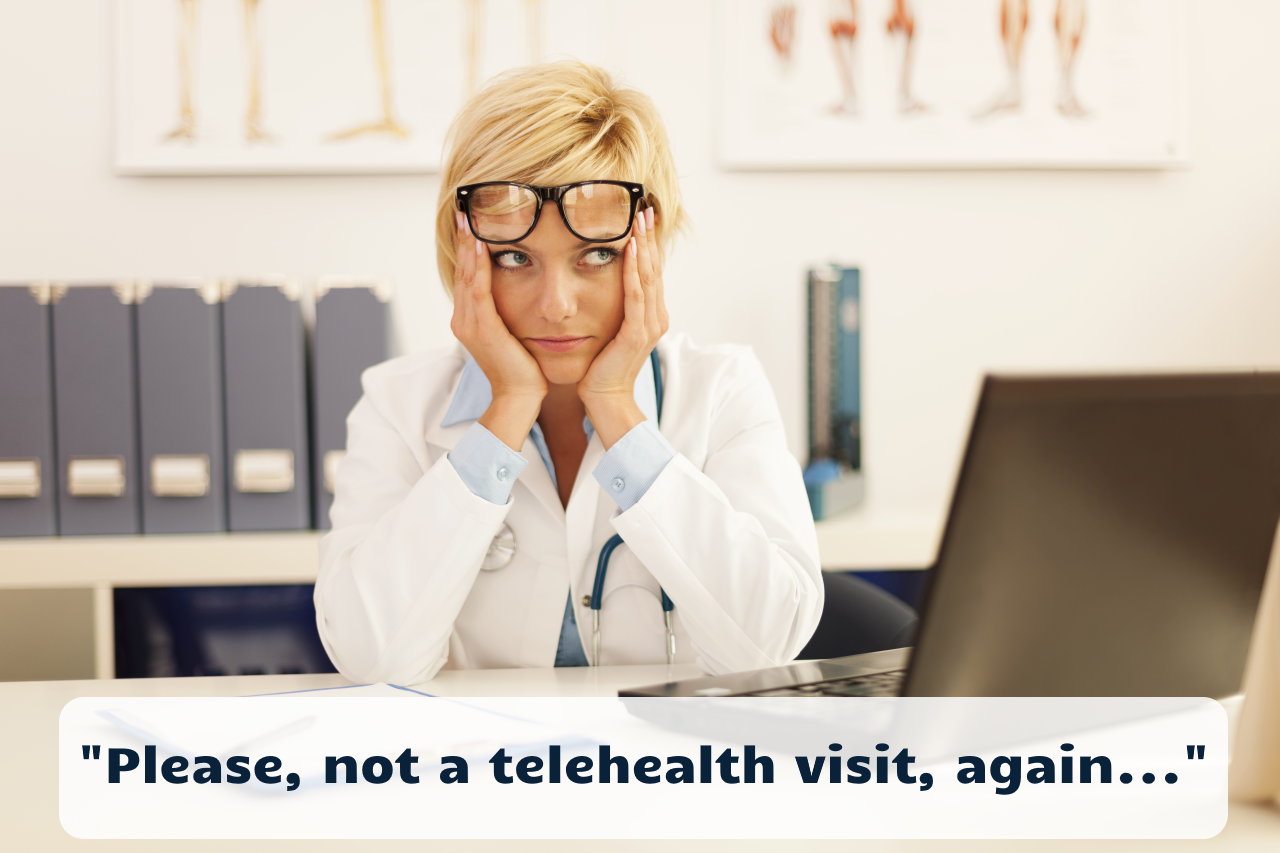Despite the fact that Covid-19 demonstrated the feasibility and value of telehealth, the majority of clinicians — especially in smaller organizations, such as health centers or rural health systems — still eschew the use of telehealth.
In other parts of the diverse healthcare system, many clinicians have fully embraced telehealth (even having made it their full-time job) or are delivering their care in a “virtual first” model.
If you are puzzled why your clinicians (still) don’t like telehealth, here are the 5 main reasons:
- Ignorant Leadership
- Undefined Workflows
- Frustrating Technology
- Little Competence & Confidence
- Unprepared Patients
Problem 1: Ignorant Leadership
Change starts at the top and if neither the executive leader nor the medical leader are embracing telehealth (still labeling it as a “stop-gap measure” or as something only “suburban millennials” want), then even the clinicians who want to embrace telehealth will have a hard time.
To not embrace telehealth as of August 2022, however, borders on willful ignorance. Many commercial insurers are moving to a “virtual first” model for their employer-based care programs. Amazon Care and Walmart Health are doing so as well, and retail giants such as CVS and Dollar General have announced plans to offer telehealth endpoints in their frequented retail locations. Even McDonald’s in rural Virginia is touting “telehealth for employees” as a recruitment tool.
Conversely only 17% of Baby Boomers that had a telehealth visit explicitly would not want a telehealth visit again (within the next 12 months). Whereas 51% said “yes” to telehealth and the rest were unsure. Gen Z, Millennials, and Gen X all were largely interested in telehealth with only 8%, 5%, and 9%, respectively, rejecting telehealth.
The solution? A leadership team that embraces telehealth as a viable, alternative care delivery option (lest they want their clinic or health system to fade into oblivion). The key questions to answer are: WHY do we, as an organization, need to get good at telehealth? What is OUR vision for telehealth? It’s especially important for the medical leader to wrap their mind around and publicly support the appropriate use of telehealth.
Problem 2: Undefined Workflows
Whereas many critics of telehealth are quick to point to technology problems, the vast majority of telehealth breakdowns actually relate to the workflow. Or rather, the lack of well-defined workflows.
The extraordinary delivery care is a combination of clear communication and smooth handoffs, paired with excellent skills and experience. In a well-designed patient experience, each staff — from the front office, to the nurses, to the clinicians, etc. — elicits pertinent information from the patient and hands them off to the next staff member.
This is even more important in a virtual care environment where the patient is not physically with the staff. From scheduling to rooming and from the visit to the follow up: all process steps have to be well defined.
Regrettably, very few organizations have consciously designed and implemented (i.e., trained on) telehealth workflows, leading to confusion, communication breakdowns, and botched handoffs.
The solution? Define all your telehealth workflows for all your different telehealth services and then train all staff on their role and responsibilities to create a superb telehealth experience (for patients and clinicians alike!).
Problem 3: Frustrating Technology
I’ve long maintained that telehealth is NOT about the technology – except when it is. There are plenty of excellent, usable (or even user-friendly) telehealth solutions available. Yet often the decision as to which solution would create the best patient and the best clinician experience is left to IT people or administrators and rarely is the input from clinicians or nurses considered.
Oftentimes telehealth technologies are selected from existing vendors, nowadays more and more from the rapidly developed telehealth features offered by the organization’s EHR vendor. As if EHR vendors haven’t demonstrated enough that their forté is billing accuracy, not to create a super experience for the clinicians or patients (think: frustrating, unusable patient portals).
The Solutions? First off, involve the actual users of the telehealth software in the decision making process. Next, define your workflows and desired patient experience and clinician experience BEFORE you review different vendor solutions. Thirdly (see problem #4), train everyone on the features (and idiosyncrasies) of the telehealth solution. Most clinicians are prone to not ask questions or for help (lest they look technologically inept).



Problem 4: Little Competence & Confidence
I get it — after working with physicians and other clinicians for over 20 years, I understand that change in healthcare must be undertaken very carefully. In healthcare, the consequences of failure are not merely lost orders, broken equipment, or a frustrating customer experience. For patients, the consequences of failure can be life altering or life ending. Therefore change has to be undertaken very carefully and consciously.
“Hey, let’s try out this new tool” may be a great idea for a car mechanic, but not so easy for a clinician.
Once the exam room door closes, clinicians are also very accustomed to feeling (and being) highly competent. They’ve seen hundreds of patients before, ran through similar motions many times, and use their experience to confirm hunches and make decisions quickly.
But their competence and confidence, up until recently, was limited to the exam room. With telehealth, the familiar environment (and the ability to control the patient in the environment) are lost or made increasingly more difficult. And with lack of competence, comes a loss of confidence. Which typically is the last things professionals want to experience — so they’d rather avoid the situation (or, in our case, telehealth) altogether.
The solutions? Support and leadership from the chief clinician and the chief executive (problem 1). A little training on webside manners, on the workflows (problem 2), and on the technology (problem 3). Once competence is built, confidence will quickly follow.
Problem 5: Unprepared Patients
Today’s healthcare system has trained most patients well into using the current in-person care delivery system the way that the system wants it: drive to the clinic; park the car; check in with the front desk (and pay up front); have a seat in the waiting room; fill out some forms; wait a bit; wait a bit more; see the physician; stop by the check out desk; etc.
Yet the process for telehealth is also quite new for patients, not just the clinicians. It’s not only that the steps are different, but also that many things (such as co-pays or forms) are handled differently (or sometimes not at all).
In addition, despite people’s willingness to do telehealth, not every patient is digitally literate to navigate the inevitable small challenges that a telehealth visit can bring with them.
Few things are more frustrating to clinicians than a patient who is not ready for them when they are ready for the patient. Talk about breaking paradigms from the clinician being in control to having to rely on the patient to show up…
The solutions? In the wake of Covid we quickly instituted for our clients “Telehealth TechChecks” – quick training sessions for patients new to telehealth to double-check their setup and prepare them for a good visit. And ultimately it also depends on the workflow for the rooming and the post-visit steps, so that patients can have a smooth experience (albeit without the drive or the waiting room).
Getting Clinicians to Like Telehealth
At the risk of making this too simplistic: Physicians like telehealth if they are good at it and if it allows them to practice medicine “on top of their license”, doing only those things that only they can do (and that does not include troubleshooting an Apple phone’s camera access permissions).
Therefore, focus all of your telehealth optimization efforts on the clinician experience and on the patient experience — and once your clinicians will (at last) like telehealth, success will follow.
Stumped by a lack of telehealth adoption in your organization? Schedule a chat with Christian to analyze your unique challenges and discuss tactics to overcome them.








To receive articles like these in your Inbox every week, you can subscribe to Christian’s Telehealth Tuesday Newsletter.
Christian Milaster and his team optimize Telehealth Services for health systems and physician practices. Christian is the Founder and President of Ingenium Digital Health Advisors where he and his expert consortium partner with healthcare leaders to enable the delivery of extraordinary care.
Contact Christian by phone or text at 657-464-3648, via email, or video chat.







Leave A Comment